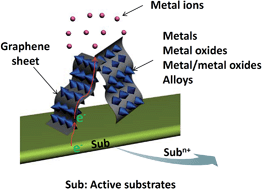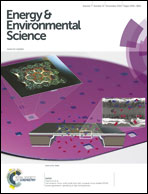A powerful approach to functional graphene hybrids for high performance energy-related applications†
Abstract
Pore-rich graphene networks hold great promise as advanced supporting materials of metals and metal oxides for high electrochemical performance. In this work, a dual substrate-assisted reduction and assembly (DSARA) process has been devised and demonstrated as a general approach for the spontaneous reduction of graphene oxide, well-organized assembly of reduced graphene oxide into three-dimensional porous networks, and simultaneous functionalization of graphenes with metal-based nanocomponents on demand, including metals, metal oxides, metal/metal oxide hybrids or alloys. The newly designed process avoids the use of toxic reducing agents, multiple steps, and long reaction times, and offers a facile but powerful pathway to greatly enhance the merits of using pristine graphenes in energy-related applications such as lithium ion batteries, fuel cells, photoelectric conversion devices, and so on. Specifically, as an anode material in a lithium ion battery (LIB), the DSARA-produced RGO decorated with NiO/Ni nanohybrids presents a record capacity with a high charge–discharge rate compared to those reported so far for Ni based materials. PdPt alloy nanoparticles on 3D RGO generated by DSARA exhibits a highly efficient catalytic performance for the oxygen reduction reaction (ORR) in fuel cells.


 Please wait while we load your content...
Please wait while we load your content...